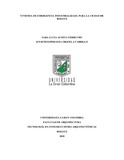Mostrar el registro sencillo del Documento
Vivienda de emergencia industrializada para la ciudad de Bogotá
| dc.contributor.advisor | Ruiz Hernández, José Alcides | |
| dc.contributor.author | Acosta Ferrucho, Sara Lucia | |
| dc.contributor.author | Orjuela Carrillo, Julieth Esperanza | |
| dc.date.accessioned | 2019-05-27T17:04:28Z | |
| dc.date.available | 2019-05-27T17:04:28Z | |
| dc.date.issued | 2018 | |
| dc.identifier.uri | http://hdl.handle.net/11396/3379 | |
| dc.description | El presente documento muestra el proceso y resultados de un prototipo de vivienda de emergencia con los parámetros de industrialización. Su metodología a emplear fue de tipo practica experimental, desarrollando diferentes formas de modulación, siguiendo los principios de industrialización, se empleó un patrón hacia la vivienda identificado la cantidad de módulos a emplear teniendo en cuenta los materiales a utilizar. Se identificó mediante un cuestionario las respuestas manejadas por parte de las unidades de riesgo La Cruz Roja y El IDIGER, investigando con esto la zona a intervenir para el desarrollo delprototipo de vivienda de emergencia. Teniendo en cuenta que las viviendas de emergencias son una de las prioridades más importantes que deben tenerse a la hora de un desastre de cualquier índole, observando cómo se han venido desarrollando distintos tipos de vivienda y como la construcción industrializada ha sido utilizada no solo para vivienda de interés social si no que atreves de los años ha sido una de las respuestas que ha dado solución ante un desastre de gran magnitud | spa |
| dc.description.abstract | This document shows the process and results of a prototype of emergency housing with industrialization parameters. His methodology to be used was experimental type, developing different forms of modulation, following the principles of industrialization, used a pattern to the housing identified the number of modules to be used taking into account the materials to be used. The responses handled by the Red Cross and El IDIGER risk units were identified through a questionnaire, investigating with this the area to be intervened for the development of the emergency housing prototype. Taking into accountthat emergency housing is one of the most important priorities that must be taken at the time of a disaster of any kind, noting how different types of housing have been developed and how industrialized construction has been used not only for housing of social interest if not that through the years has been one of the answers that has given solution to a disaster of great magnitude | spa |
| dc.format.mimetype | application/pdf | |
| dc.language.iso | spa | |
| dc.publisher | Universidad La Gran Colombia | spa |
| dc.rights.uri | https://creativecommons.org/licenses/by-nc-nd/2.5/co/ | * |
| dc.source | instname:Universidad La Gran Colombia | |
| dc.source | reponame:Repositorio Institucional UGC | |
| dc.subject | Vivienda de emergencia | |
| dc.subject | Cruz roja colombiana | |
| dc.subject | IDIGER | |
| dc.subject | construcciónindustrializada | |
| dc.subject | Modulación | |
| dc.subject | Construcción enserie | |
| dc.title | Vivienda de emergencia industrializada para la ciudad de Bogotá | spa |
| dc.type | bachelorThesis | |
| dc.subject.lemb | Construcción de casas | |
| dc.publisher.department | Facultad de Arquitectura | spa |
| dc.publisher.program | Tecnología en Construcciones Arquitectónicas | spa |
| dc.type.spa | Trabajo de grado | spa |
| dc.rights.acceso | Abierto (Texto Completo) | spa |
| dc.publisher.branch | Bogotá | spa |
| dc.rights.accesRights | info:eu-repo/semantics/openAccess | |
| dc.type.hasversion | info:eu-repo/semantics/acceptedVersion | |
| dc.creator.degree | Tecnólogo(a) en construcciones arquitectónicas | spa |














